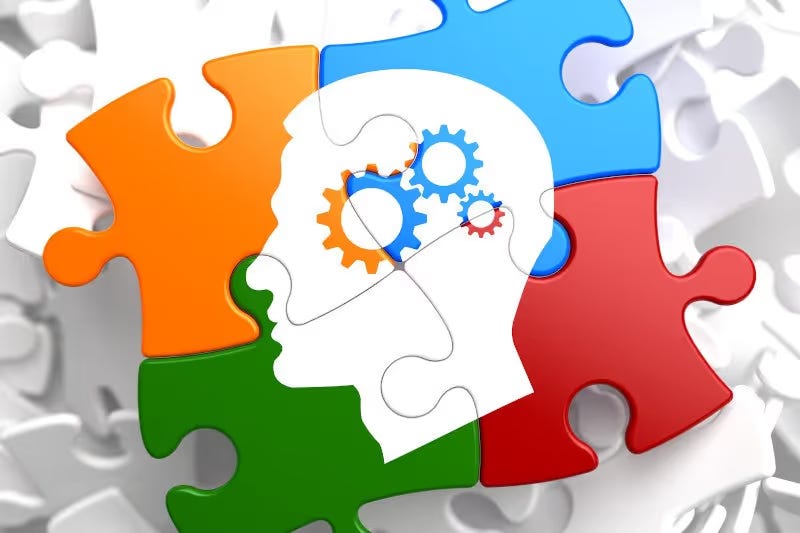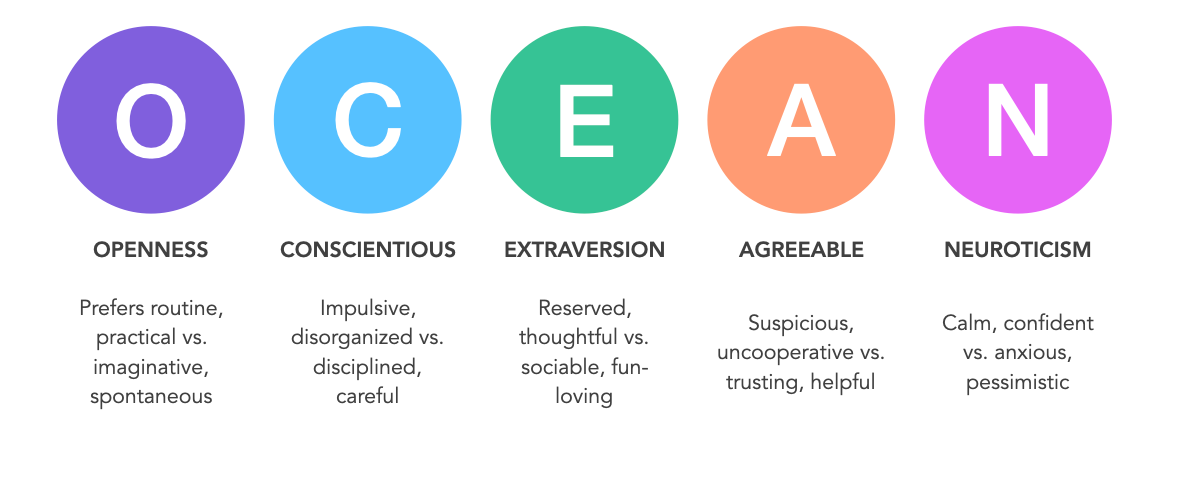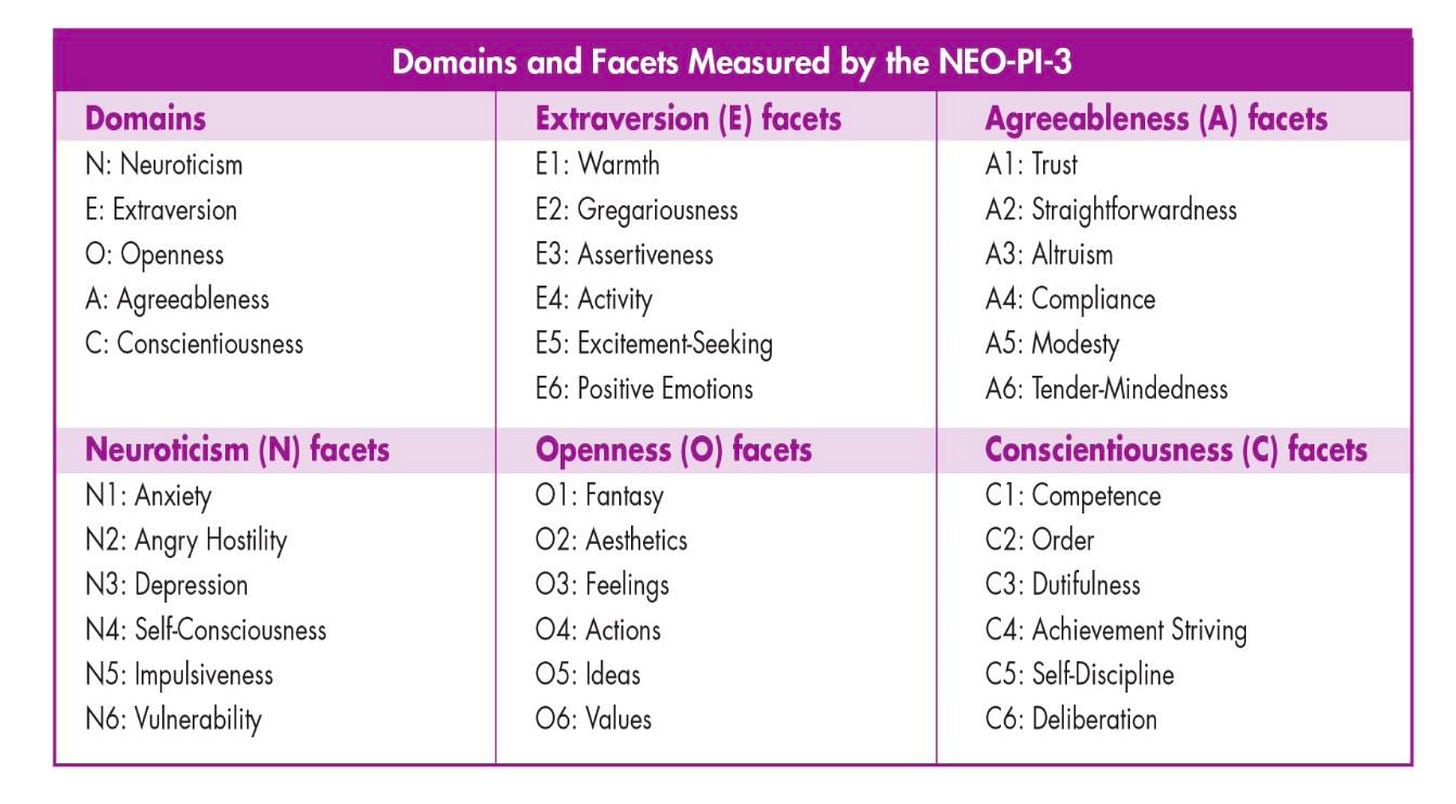Understanding Personality Tests
Psychometric personality testing principles, limitations, and usefulness.
What is personality?
As personality psychologist Jordan Peterson puts it, personality is an evolved solution to life’s perennial problems.
Personality functions by influencing our perceptions, motivations, emotions, and actions such that people actually experience and perceive the world differently .
Personality refers to the enduring characteristics and behaviors that make up a person's unique adaptation to life, including core traits, interests, drives, values, self-image, skills, and emotional patterns. It's your makeup-your basic instinct to think, feel, and act.
Personality influences our perceptions, motivations, emotions, and actions, so people with different personalities experience and perceive the world differently.
Personality and character
Personality is your predisposition—your basic instincts for how to think, feel, and act. Character is your capacity to prioritize your values over your instincts.
Knowing your principles doesn’t necessarily mean you know how to practice them, particularly under stress or pressure. It’s easy to be proactive and determined when things are going well. The true test of character is whether you manage to stand by those values when the deck is stacked against you.
If personality is how you react on a typical day, character is how you show up on a tough day. Personality is not your destiny—it’s your tendency. Character skills enable you to transcend that tendency to be true to your principles. It’s not about the traits you have—it’s what you decide to do with them.
Why is it important for people to understand what personality is?
The basic reason you need to understand the psychology of personality is that you are a person in a social world. You have a personality and you have to deal with other personalities. When working together to solve problems, human groups that include many different personalities are better able to adapt to an ever-changing environment because they benefit from a diversity of opinions.
Learning what personality is and how it works can help you understand yourself and those around you. Understanding the psychology of personality can help you interact more harmoniously with others and excel in cooperative activities.
Learning that you have a high level of a particular trait can help you better understand your own behavior patterns, better evaluate your decisions and choices, and better choose your relationships.
What is a personality test?
The term “psychometrics”, derived from the Greek “psyche” (mind) and “metron” (measurement), means “the measurement of psychological traits”. The aim of a psychometric assessment is to gain a better understanding of a person's fundamental aptitudes, such as personality or intelligence.
A test can be described as “psychometric” insofar as it is standardized, has norms and has been the subject of scientific validation studies.
Unlike assessments, which are based on subjective perceptions, psychometric tests make it possible to study the characteristics and differences between individuals or groups of individuals, based on an objective statistical approach.
The proliferation of personality and intelligence tests should not blind us to the quality requirements specific to the objective assessment of individuals.
Valid psychometric measures must meet the following conditions:
They must predict the same thing as other similar measures.
They must measure something unique that other measures do not capture.
They must help us understand something important and useful in practice.
Three validation criteria are used to guarantee the effectiveness of psychometric tools:
Reliability: This refers to how well a test measures a given dimension (stability of results, consistency of measurement). A test that provides similar scores when taken repeatedly is considered reliable. The acceptable level of reliability depends on the type of test and the type of coefficient used.
Validity: This refers to the characteristics measured by the test and the accuracy with which it assesses these characteristics. Evidence of validity indicates that there is a link between test performance and a specific performance criterion. It informs us about the degree to which it is possible to draw specific conclusions, or predictions, about the individual based on his or her test score. In other words, it tells us how useful the test is.
Sensitivity: The sensitivity of a test refers to its discriminating power, i.e. its ability to distinguish one individual from another.
Which personality test is the most reliable?
There are many personality tests, but two are particularly well known:
The Big Five Inventory (BFI) or 5 Factor Test, and the Myers-Briggs Test (MBTI). These tests have been scientifically validated, proving that they actually measure what they claim to measure.
One of the key differences between the Big Five Inventory and the MBTI is the way they present their results and categorize personalities.
The MBTI divides individuals into 16 distinct personality types. It does this by assigning one of two letters four times (e.g., I for introversion and E for extraversion, S for sensing and N for intuitive, etc.). As a result, the range of personality traits tested is much wider.
In contrast, the Big Five personality test, is more focused, providing specific information on 5 major personality traits: Openness, Conscientiousness, Extraversion, Agreeableness, and Neuroticism (hence the acronym O.C.E.A.N).
Myers-Briggs (MTBI)
The four MBTI personality types are Introversion/Extroversion, Sense/Intuition, Thinking/Feeling and Judgment/Perception. The test is based on the principle of these four personality categories. You are assigned one of two traits from each category, resulting in the 16 different MBTI personality types - such as INTJ or ESFP.
An estimated 2 million people take the MBTI test every year. However, the popularity of this psychometric test is not necessarily an indication of its accuracy and usefulness. The Myers-Briggs test is not considered scientifically valid. Many criticize its underlying theory and the rigid dichotomy that tends to oversimplify personality.
For most personality psychologists, the MBTI personality test is neither accurate, reproducible, nor reliable.
To form the 16 personality types, the MBTI divides four categories into two, on the assumption that all people are either one or the other. However, most people generally fall somewhere in between, so that two people with very similar scores can obtain completely different results. People who are relatively close to the mid-point of certain dimensions are classified in both categories, even if they don't lean strongly towards a specific trait.
It's crucial to understand why people are attracted to this type of test, and whether the categories have any practical application.
Even if personality profiles are generic, people often feel that the descriptions reflect their self-image. This self-validation error is called the Barnum effect, which describes a person's tendency to believe that vague descriptions are specifically tailored to him or her. This psychological phenomenon may also explain the appeal of astrology and fortune-telling.
In addition to self-assessment, personality tests also enable individuals to identify with a particular category that encompasses who they are as a person, making them feel understood and fostering a sense of belonging to that group.
The Big Five Inventory (BFI)
The Big Five Inventory (BFI) is a rigorous psychometric research study published by psychologists John, Donahue and Kentle in 1991. It’s branded and sold as the NEO™ Personality Inventory-3.
This test is appropriate for ages 12 years and older. It has demonstrated utility in clinical, applied, and research settings and it’s useful in vocational counseling, pre-employment screening, and educational psychology.
The Big Five factors are not derived from a theoretical perspective, but have been identified through empirical analysis of natural language and psychological tests, with the aim of identifying personality traits that are independent of each other and describe personality as comprehensively as possible.
The researchers identified 5 independent personality traits that do not correlate with each other in any population. This model is unique in that it was developed empirically; the scientists who developed it made very few prior assumptions. After analyzing people's answers to a hundred or so questions, they found that five factors emerged:
These five factors correspond to the traits of the mnemonic acronym OCEAN :
Openness to experience (Intellect and aestheticism)
Conscientiousness or conscientiousness (Industriousness and orderliness)
Extraversion (Enthusiasm and assertiveness)
Agreeableness (Compassion and politeness)
Neuroticism or neuroticism (Withdrawal and volatility)
Each factor is subdivided into six subcategories.
Each trait is represented by a percentile, relative to the general population. For example, you may have a higher level of extraversion than 82% of the population, but a higher level of agreeableness than only 30%.
The Big Five model is the psychometric personality test most commonly used in psychology studies, and is widely regarded as the most scientifically validated. Experts have found that these traits are universal and provide,an accurate portrait of personality. Human resources professionals and psychologists use this information in orientation tests to recruit and evaluate candidates.
Unlike the MTBI personality types, the Big Five's trait-based approach proposes positioning an individual's characteristics on a continuum for each facet of his or her personality. The Big Five adopts this approach and limits itself to a positioning on 5 different “scales”. The number of personalities that can be distinguished is therefore virtually infinite, and this makes it possible to avoid placing individuals in boxes. This approach simply describes the individual's position on each of the 5 personality dimensions.
How do I take a personality test?
In general, it is recommended that a qualified personality psychologist administer the NEO™ Personality Inventory-3 and help you understand the results.
Alternatively, you can take this online personality test based on the Big Five framework to determine your 5 key personality factors. It will tell you more about yourself and help you identify your strengths and weaknesses. This open source test, created by the IPIP scientific community, is free and represents a scientifically reliable psychometric model. It contains 120 questions and should take about 10-15 minutes to complete.
I also recommend the personality assessment and report “Understand Myself”, based on the Big Five Aspects Scale and developed by the renowned personality psychologist Jordan Peterson.




